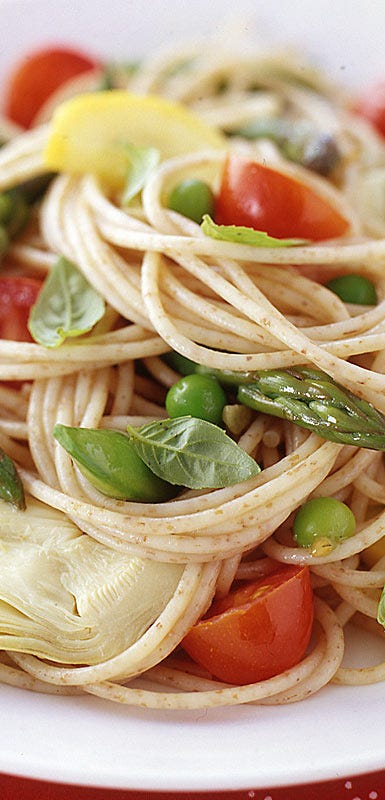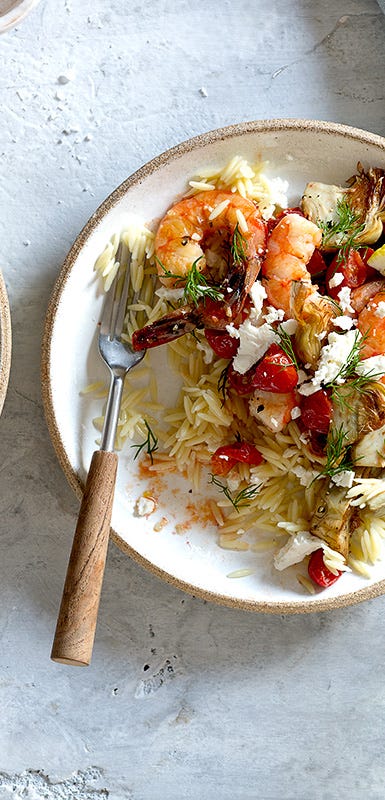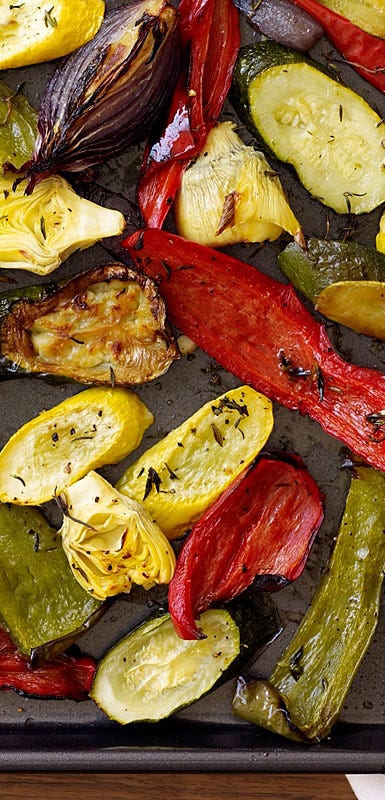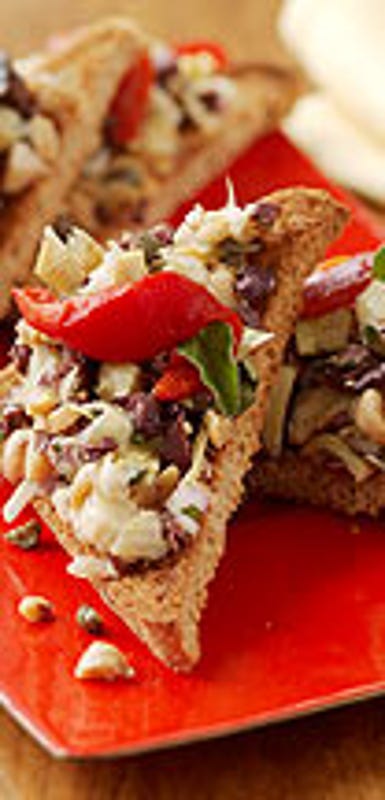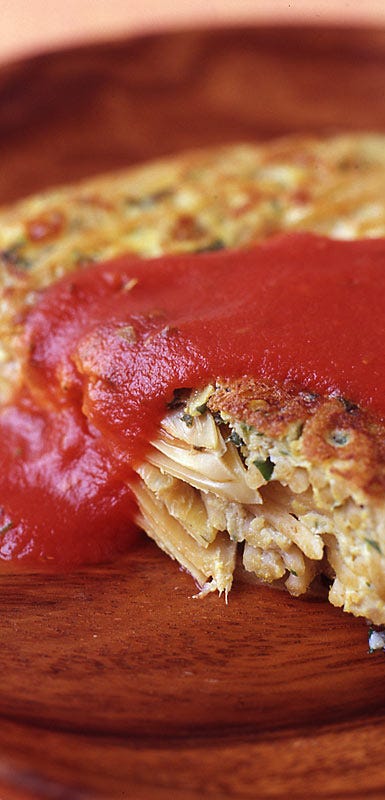The skinny on artichokes

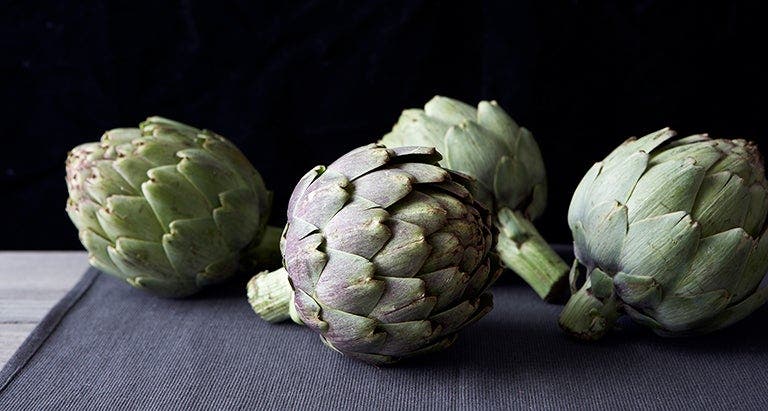
Artichokes are a powerhouse of nutrition and fiber — but more importantly, they’re flavorful and fresh, a great addition to a meal — or a light meal on their own. We’ll give you everything you need to know to get them on the table.
Ever eat a flower? If you’ve eaten an artichoke, you have. These relatives of the roadside thistle are a favorite Italian staple that’s now become an American mainstay. They’re fresh, flavorful and nutritious. Best of all, they’re available almost all year round.
Just the facts
An artichoke is a powerhouse of fiber. Per serving, it has more fiber than lima beans, prunes or green peas.
It’s also a storehouse of potassium, magnesium and vitamin C.
Since an artichoke is a flower, it certainly has a different anatomy from a carrot or a potato! It’s made up of many petals surrounding an inner core.
Think of it as a flower bud writ large: the heart is the meaty center; the heart is topped by a fuzzy choke; and these bits are all enclosed by layers of petals. True to their thistle nature, the large, tough, outer leaves can each be topped by a small thorn. (There are also thornless varietals.)
In the end:
- Two parts of a large, mature artichoke are inedible: the very tough, outer leaves and the hairy choke.
- Four parts are edible once cooked: the stem; the tender heart under the choke; the yellow, soft, inner leaves; and the “meat” inside the inner curve of some of the pale green leaves.
What you may find at the store
Although there are at least nine varietals, since the 1920s, the United States has become a world leader for the production of the big green globe artichoke, familiar from most grocery stores.
However, this common varietal can look different at different times of year: in the spring, the globes are compact and tight; in the summer, the leaves open up, the artichoke starting to show its flowery nature; and in the fall, artichokes can get a rusty tinge from colder weather.
That all said, there are sweet but grassy red- and purple-tinged varietals. The Sienna, a purple artichoke, has an exceptionally small choke. It’s also one of the few varietals with a heart tender enough to eat raw.
Finally, there are two rarities worth checking out:
- Baby artichokes: These are not immature artichokes but simply the flowers farther down the stems. These haven’t developed the inedible chokes and so can be eaten whole once cooked.
- Long-stem artichokes: Basically, these are the flowers from the uppermost top and center of the plant, with their long stems still intact. The stems can be cut off and cooked separately (diced in a stir-fry, for example) — or they can be left on the flower. One note: the stems must be peeled with a vegetable peeler before cooking.
Best buying tips for fresh artichokes
Look for:
- Stems that are not desiccated or cracked.
- Intact leaves with no squishy bits in sight.
But one note: blotchy leaves are common in the winter, a result of colder temperatures.
Fresh is not the whole story
Artichokes are also available canned or frozen. In both cases, these are simply the tender, inner hearts. They are ready to eat.
Jarred artichokes can be marinated in an oily vinaigrette or canned in water. Search out the latter so the fresh taste isn’t weighed down by unwanted ingredients.
Before sautéing or braising, frozen artichokes should be thawed and squeezed of excess moisture. Frozen artichoke hearts are most often sold quartered.
Storing fresh artichokes at home
Keep fresh artichokes wrapped in airtight plastic bags in the refrigerator for up to one week. For even better freshness, sprinkle them with a little water before closing the bag. (They are flowers, after all!)
Here’s a real plus: you can cook artichokes in advance, saving them back in the fridge for several days until you’re ready to reheat them or use them in salads, stir-fries, or dips.
Prepping artichokes for cooking
Follow these steps:
- Rinse the artichokes.
- Trim the woody, dried-out ends of the stems.
- Peel the remaining stems with a vegetable peeler.
- Put one artichoke on its side on a cutting board and slice off the top inch or so of the flower (thereby removing the uppermost thorns).
- Use a pair of kitchen shears to cut off the thorny ends of the remaining outer leaves.
- To keep the artichokes from turning brown, rub all the cut parts of the flower with lemon juice — or throw the artichokes (one by one as they’re prepared) into a large bowl filled with water and the juice of a large lemon (plus the hull of that juiced lemon).
The exception here is baby artichokes. Trim off the whole stem, right down to the flower. Cut only 1/4 inch off the top of the flower. Finally, break off any dark-green petals, leaving only pale- green and yellow petals exposed.
How to cook artichokes
- Steam: Set them stem-side up in a steamer basket (so the steam can get up into the down-turned leaves). Set basket over simmering water, then cover pan and steam until tender, anywhere from 25 to 45 minutes, depending on the size of the artichokes. You know they’re done when a sharp knife can pierce the stem and heart easily (like sticking a knife into a baked potato).
- Boil: Set prepared artichokes into a large pot of boiling water. Cover, reduce heat, and cook at a moderate simmer for about the same amount of time as for steaming.
- Bake: Preheat oven to 425°F as you prepare artichokes. Spread petals open and season them inside with salt, pepper and/or minced herbs. Seal artichokes into an aluminum foil packet — then seal this packet inside another foil packet. Bake on a large baking sheet for anywhere from 1 hour to 1 hour and 20 minutes, depending on the size of the artichokes.
Once again, the exceptions are baby artichokes. Steam them for 15 minutes (no need to worry about how they go in the steamer basket), boil for 15 minutes, or bake in the double foil packet for 25 minutes. Once prepped, baby artichokes can also be quartered and sautéed or stir-fried until tender, up to 10 minutes. Or they can be quartered and added to stews with the other vegetables.
And now what?
If you’re serving whole large artichokes, you must still remove the fuzzy, inedible choke. The easiest way is to cut them in half through the stem and scrape out the soft, hairy middle with a spoon.
Baby artichokes are missing that inedible choke. They’re good to go as they are!
Break out the condiments! Dip the outer petals into your favorite condiment and scrape off the tender inner bits against your front teeth. Then knife-and-fork the tender heart, stem and inner yellow leaves, slathering them with the condiment of your choice.
Don’t just think melted butter. Try an herbed vinaigrette, cocktail sauce, barbecue sauce, mustard, chutney, ketchup, salsa, pesto or even herb-laced, well-peppered plain yogurt.
The hearts, stems and yellow leaves can also be whirred up into pesto or bean dips or chopped and added to salads (green salad, tuna salad or even egg salad). You can slice them and put in sandwiches or wraps. Or dice them and use as omelet fillings. Or chop them and set on top of a pizza.
For even more taste, throw the halved, dechoked artichokes or the whole cooked baby artichokes on a charcoal or gas grill directly over high heat for a couple minutes per side, just until a little charred with a delicate, smoky flavor.

